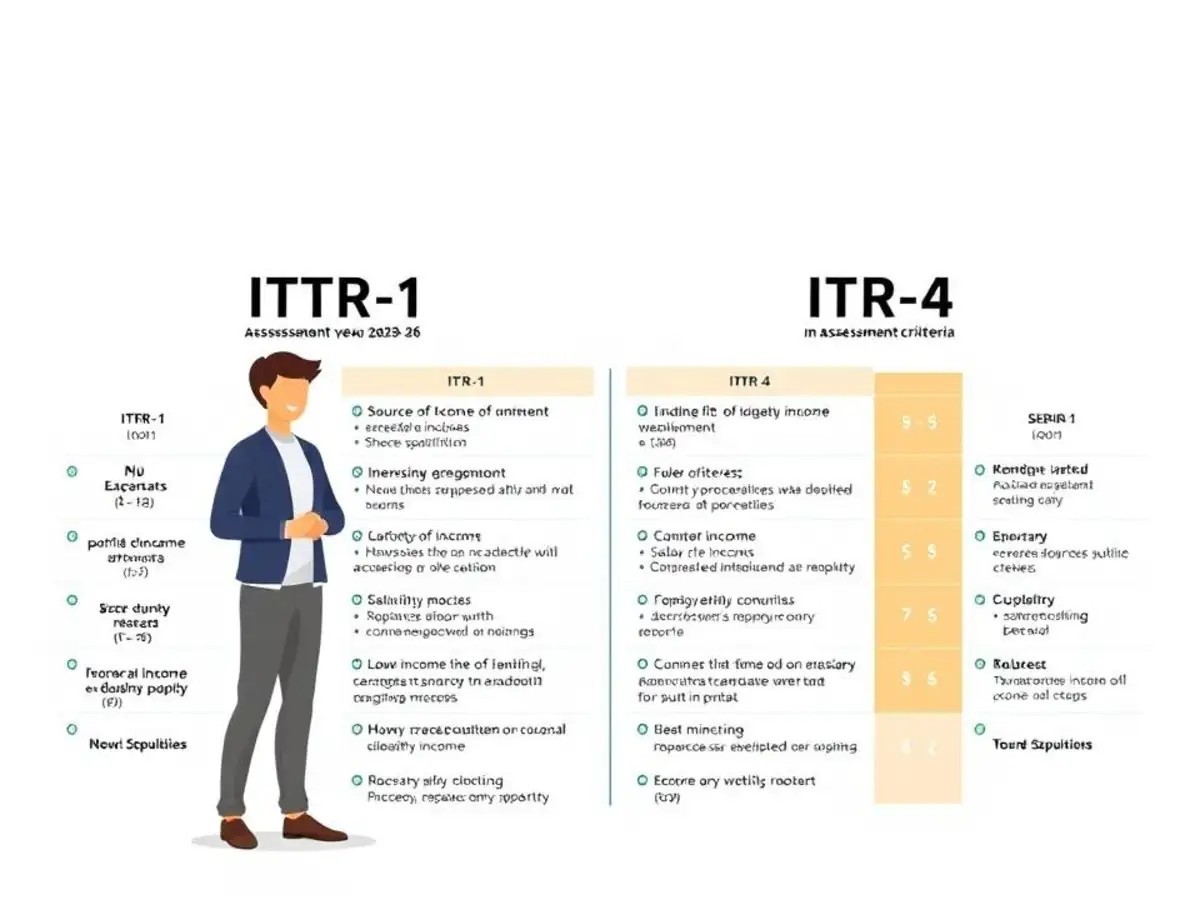Revised ITR Forms for FY25: Key Changes
“Revised ITR Forms for FY25: Key Changes”
Syllabus:
GS-2:Government Policies & Interventions
GS-3:Growth & DevelopmentPlanningGovernment BudgetingFiscal Policy
Focus:
The Indian government has introduced significant changes in the Income Tax Return (ITR) forms for the Assessment Year 2025-26 to simplify tax filing processes and improve transparency. The updates focus on capital gains, tax-saving investments, allowances, and TDS disclosures, impacting individual taxpayers across various income categories.
Key Changes in FY25 Tax Returns:
-
Introduction to ITR Form Changes
- Taxpayers must adapt to several significant changes in the Income Tax Return (ITR) forms for the Assessment Year (AY) 2025-26.
- The forms are aimed at easing compliance while expanding disclosure requirements on various aspects like tax-saving investments, House Rent Allowance (HRA), and non-salary TDS.
- Forms Affected
- Forms such as Sahaj (ITR-1), ITR-2, and ITR-3 have undergone substantial revisions.
- The changes aim to simplify tax filing for individuals with simpler income sources while ensuring transparency in more complex cases.
- New Disclosure Requirements
- Taxpayers will be required to disclose more details about tax-saving investments, loans, and TDS (Tax Deducted at Source) on non-salary income.
- At the same time, reporting on assets and liabilities has been relaxed.
- Simplified Forms for Lower Capital Gains
- Taxpayers with Long-Term Capital Gains (LTCG) up to ₹1.25 lakh from listed stocks and equity funds can opt for the simplified ITR-1 or ITR-4
- This reduces the burden on individuals with minimal capital gains, as previously, LTCG had to be reported in more complex forms (ITR-2 or ITR-3).
Understanding New Income Tax Slab Features and Rates (FY 2025-26):●Tax-Free Income: About New Income Tax Slab Rates (FY 2025-26):
Understanding New Tax Regime vs Old Tax Regime Comparison:●Introduction: ●Income Exemption Limit: ● Tax Rates and Slabs: ●Standard Deduction: ●Deductions: ●Flexibility vs. Simplicity: ●Tax Planning: ● Long-term Financial Goals: |
Capital Gains Reporting: Simplification and Disclosures
- LTCG Reporting for Stocks and Equity Funds
- ITR-1 and ITR-4 are now available for taxpayers with LTCG of up to ₹1.25 lakh from equity mutual funds and stocks, under Section 112A.
- Taxpayers can report only the total sales consideration, acquisition cost, and net LTCG without needing to disclose detailed information.
- Threshold for Simplified Filing
- The ₹1.25 lakh threshold applies after setting off any capital losses incurred in the same assessment year.
- If an individual’s total LTCG exceeds ₹1.25 lakh, they must file either ITR-2 or ITR-3, as this requires more detailed disclosures.
- Exclusion of Other Assets and Losses
- The ₹1.25 lakh limit applies specifically to capital gains from listed stocks and equity mutual funds under Section 112A.
- If a taxpayer has LTCG from other assets or a combination of short-term gains, losses, or total LTCG exceeding ₹1.25 lakh, they must opt for the more detailed ITR forms (ITR-2 or ITR-3).
- Specific Guidelines for Taxpayers
- Sonu Iyer, Partner at EY India, explains that only losses set off under Section 112A will be considered for net gain calculations.
Detailed Disclosures on Tax-Saving Investments, HRA, and Loans:
- Expanded Disclosures for Tax-Saving Investments
- New sections have been added to ITR forms, requiring taxpayers to disclose deductions under Chapter VI-A (Sections 80C, 80D, 80CCD, 80E, etc.).
- These deductions include investments in PPF, life insurance, fixed deposits, and mutual funds.
- HRA and Other Allowances
- Taxpayers claiming exemptions under HRA (House Rent Allowance), LTA (Leave Travel Allowance), and other allowances will need to provide more detailed information.
- This includes furnishing the rent paid, the landlord’s details, and the amount exempted under Section 10(13A).
- Loan Details for Taxpayers
- Those claiming deductions for housing or education loans will need to submit more detailed information, including the loan amount, interest paid, and the lender’s information.
- Easing the Compliance Process
- While the disclosure requirements have expanded, the system has introduced drop-down menus to make it easier for taxpayers to select and report the relevant details.
- This system is designed to reduce errors and improve accuracy in filings.
New Rules for Capital Gains and Tax Rate Changes:
- Capital Gains Tax Rate Changes (Finance Act 2024)
- Changes in the tax rates for capital gains have come into effect, with a uniform rate of 12.5% now applicable across all asset classes, as opposed to the previous 10% rate for equities and 20% for other assets.
- Taxpayers now need to separately report capital gains made before and after July 23, 2024, which is critical due to varying tax rates and indexation benefits.
- Real Estate and Other Asset Disclosures
- For real estate properties acquired before July 23, 2024, taxpayers will have the option to choose between two tax regimes: 5% without indexation or 20% with indexation.
- These changes are particularly relevant for those using the Capital Gains Account Scheme (CGAS), where gains from sales intended for reinvestment in real estate are kept.
- Separate Reporting for Pre- and Post-Change Capital Gains
- ITR forms now require taxpayers to report gains separately for transactions that occurred before and after July 23, 2024.
- This differentiation is crucial to calculate accurate tax liability, especially for taxpayers involved in both real estate and other capital assets.
Enhanced TDS Reporting and Asset Disclosures:
- TDS on Non-Salary Income
- The new ITR forms require detailed reporting of TDS (Tax Deducted at Source) on non-salary income, including income from dividends, interest, and other sources.
- Taxpayers must reconcile the TDS information with Form 26AS and AIS (Annual Information Statement) to ensure that the deductions reported match the actual amounts deducted at source.
- Asset and Liability Reporting for High-Income Taxpayers
- A significant change is the increase in the threshold for reporting assets and liabilities under Schedule AL, from ₹50 lakh to ₹1 crore.
- Taxpayers with income exceeding ₹1 crore must disclose details about immovable properties, financial assets, vehicles, jewelry, insurance policies, and other significant assets and liabilities.
- Impact on HUFs (Hindu Undivided Families)
- Hindu Undivided Families (HUFs) are no longer eligible to file ITR-1. They will need to file ITR-2, ITR-3, or ITR-4, depending on their sources of income.
Conclusion: Preparing for the New ITR Forms
- Final Filing Deadline and Recommendations
- The deadline for filing ITR for AY2025-26 is set for July 31, 2025. However, taxpayers are encouraged to file their returns early to avoid errors due to the new complexities in the forms.
- Taxpayers should also maintain thorough documentation and cross-check their forms with TDS certificates, Form 26AS, and AIS to ensure accuracy in their filings.
- Ensuring Accuracy in Reporting
- With the new additions and disclosures in the ITR forms, it’s crucial for taxpayers to carefully review and reconcile all income, deductions, and tax paid at source.
- Proper documentation and timely filing will be key to avoiding errors and ensuring compliance with the updated tax rules.
Conclusion:
The changes in the ITR forms are aimed at simplifying tax filing for individual taxpayers, especially with a focus on capital gains, tax-saving deductions, and disclosures of assets and liabilities. By improving accuracy and transparency, these reforms are expected to foster better tax compliance while easing the filing process.
Source: Mint
Mains Practice Question:
“Discuss the key reforms in the Income Tax Return (ITR) forms for Assessment Year 2025-26. How will these changes impact taxpayers, particularly with regard to capital gains, TDS reporting, and disclosure requirements? Analyze their potential effects on tax compliance and ease of filing in India.”





